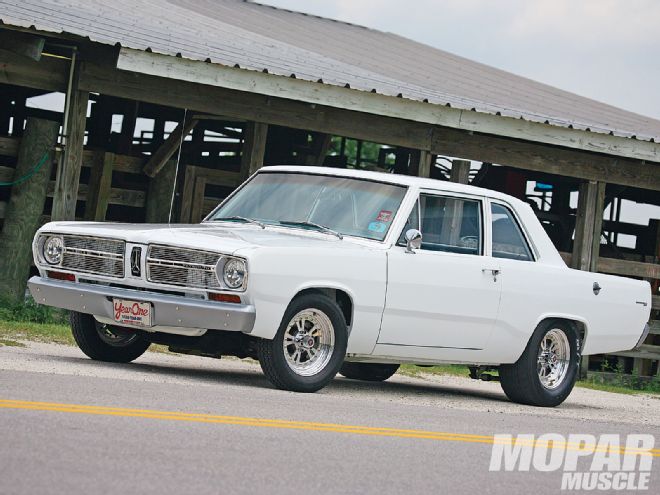
When it comes to the appearance of a car, wheels and tires can make or break the entire package. Now, the right package is all in the eye of the car owner, and some guys like the stock look of hubcaps, and yet for others, a Rallye or Magnum wheel is the perfect "hot rod," muscle car wheel.
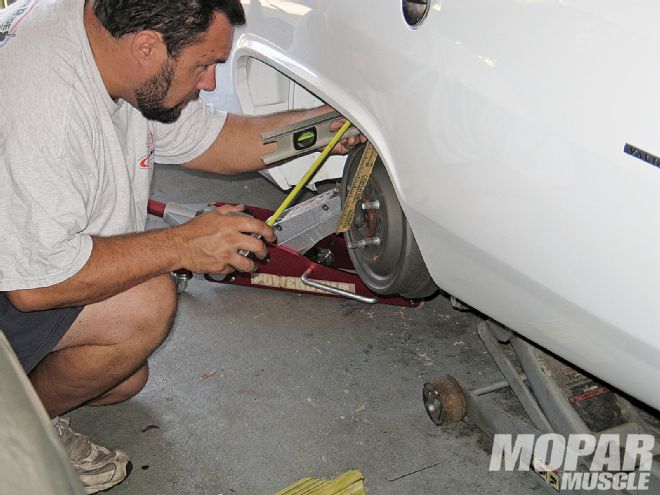
When it comes to questions we get about wheel and tire combinations, it seems that everyone wants to know "what's the biggest tire I can fit on my car?" The answer is, we don't know. No, we're not complete idiots, but there are too many variables involved when it comes to measuring for tire fitment on an individual car, it really is not a "one size fits all" scenario. Things like brakes, suspension, and even the exhaust can interfere. It's for this reason that aftermarket wheel manufacturers have enabled enthusiasts to-to a degree-order wheels in custom sizes.
We decided to do some upgrading to the wheel and tire combination of a car, and when we thought about it, we realized that the vehicle with one of the smallest areas for tire clearance is an early A-Body. We figured that would be a great test bed for "stuffin' a fatty," as the title put it. The '67 through early '70s "small cars" were never intended to house large rear tires. Even the '68 Hemi Barracudas and Darts came with a "skinny" wheel and tire combo that would need to be changed.
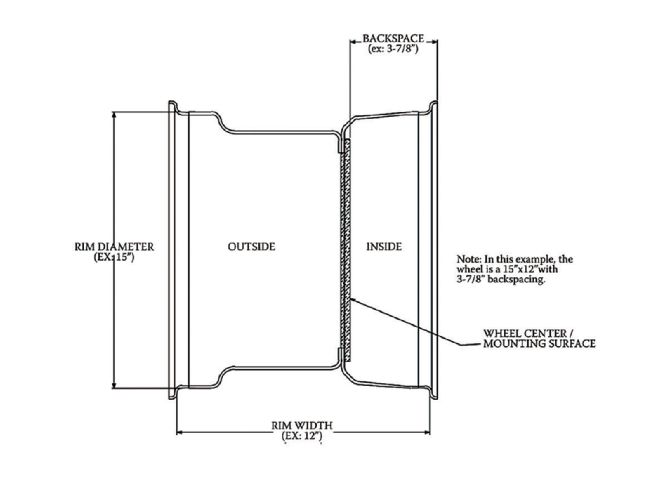 If you measure from the diameter (rim's edge), there should be nothing within 1 1/4 inches of it. We have found this to be a safe measurement. This gives the tire room for expansion when mounted, and flex when cornering.
If you measure from the diameter (rim's edge), there should be nothing within 1 1/4 inches of it. We have found this to be a safe measurement. This gives the tire room for expansion when mounted, and flex when cornering.
Project Valiant Effort, our '67 Valiant, has been around for quite some time, and many of you have seen the Valiant in its "sleeper" style with 14-inch Rallye wheels, and small 225/14-inch radial tires. It looked for all intent and purpose like a car that anyone's grandmother would take to church on Sunday. But, would a simple wheel and tire swap make a difference in the car's attitude?
The problem with fitting a larger tire in the rear wheelwell of the Valiant is that not only is the car an A-Body, but it has a '68 B-Body 8 3/4 rear underneath it. Since a factory A-Body rear is just shy of 51 1/2 inches flange to flange, and the B-Body is 55-inches flange to flange, we essentially lose approximately 3.6 inches of usable area if the backspacing is theoretically at zero.
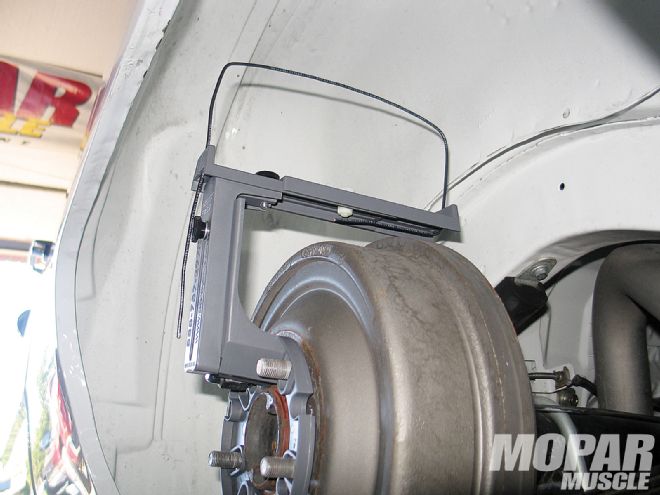 If you're not sure about measuring the old fashioned way for wheel and tire fitment, Percy's WHEELRITE may just be for you.
If you're not sure about measuring the old fashioned way for wheel and tire fitment, Percy's WHEELRITE may just be for you.
Now we said earlier that you can order wheels with different backspacing, but even that is limited. Most aftermarket wheel companies offer backspacing in 1/4 and 1/2-inch increments, and sometimes, that just won't do. We did find a company that will make you a custom-offset wheel that comes in 7/8-inch increments. Since we knew that an off-the-shelf wheel wasn't going to fit our application, we decided to check out the wheel offerings from Holeshot Wheels. Holeshot Wheels has more than 20 different styles of 15- and 16-inch diameter wheels for you to choose from. Depending on the wheel size, the standard backspacing available is 7/8 inch to 8 7/8 inches. Their standard backspacing is measured on the 7/8-inch mark, in 1-inch increments. For example, on a 15x15-inch wheel, the standard backspacing available would be: 3 7/8, 4 7/8, 5 7/8, 6 7/8, 7 7/8, and 8 7/8 inches. They also offer backspacing on the 1/2- and 3/4-inch increments, but there is an additional cost for those measurements. One aspect to keep in mind is that Holeshot wheels are not D.O.T approved, and are considered an off-road or race wheel. We won't tell if you don't.
But how do you know what size wheel and tire will fit your car? Here is where a lot of guys get confused about the measurements. You'll need to know how much backspace will fit, the overall width you have room for, and what diameter wheel and bolt pattern of the wheel you need. To measure for the backspace, take a straight edge that is at least as large as the wheel/tire combination you plan to use, and place it against the brake drum (or rotor face if using disc brakes) where the wheel mounts. Now you can take a measuring device (tape measure or ruler), and measure the distance from the straight edge to the part of the car's suspension, brake system, or whatever, that is closest to the straight edge, and that is outside of the wheel's diameter (see diagram above). You'll also have to make sure that if using an aftermarket disc brake kit, that the brakes will fit inside of the rim's diameter.
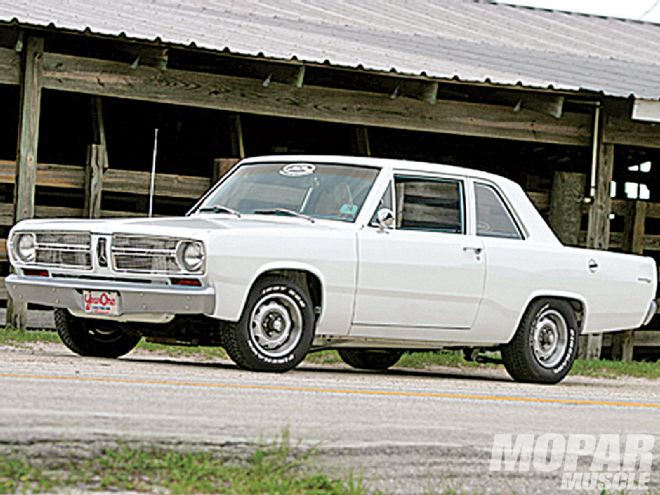 For years, the Valiant surprised a lot of people with its pedestrian looks. It's time to change that.
For years, the Valiant surprised a lot of people with its pedestrian looks. It's time to change that.
The next measurement you need to get is the overall rim width (see diagram above). Again, measure using the straight edge and a ruler to find out how wide a wheel will fit in your opening-remember to leave about 1 1/4 inches of clearance. We used a straight edge with measure lines on it, and measured for our clearance 7 1/2 inches from the center of the axle hub outward, which gave us an overall wheel diameter of 15 inches.
If you really want to be sure you have the right fitment, you can contact Percy's High Performance, and get one of their WHEELRITE tools. This tool takes any guess work out of deciding on a wheel and tire size.
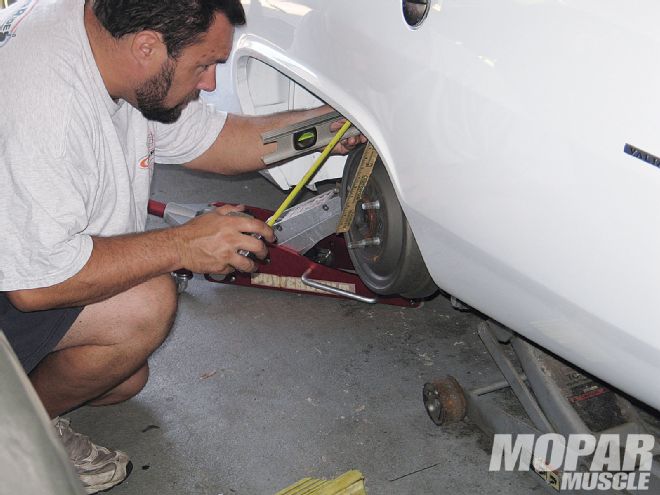 The first thing to do is remove the wheel and tire, and get to measuring.
The first thing to do is remove the wheel and tire, and get to measuring.
Now, back to measuring. When you are comfortable with the measurements you have taken, now you need to decide what tire will fit your wheel and opening. Tires have a couple of measurements you need to pay attention to-section width, tread width, sidewall height, and overall diameter. Section width is the actual width of the sidewall at its widest point, after the tire is mounted and inflated. It's this measurement that gives cause for the 1 1/4-inch spacing between the rim edges and the vehicle. Tread width is self explanatory; it's the width of the tread pattern. Sidewall height is the distance from the rim to the tread, and overall diameter is, well, the diameter of the tire after mounted.
Now that we have the technical stuff out of the way, it's time to get down to the looks. Like I said, we decided on a set of Holeshot Wheels, and we really liked the Sun Star 5-spoke style wheel. Now, the sleeper look of the Valiant with the 14-inch Rallye wheels was ok, but it was definitely time to give the car a new attitude. After doing some measuring out back, we came up with a rim size of 15 x 8 inches, with a backspace of 5 7/8. Now, the Valiant has a 3/4-inch offset shackle setup, so these measurements may not work for your A-Body. With this rim size, A Mickey Thompson ET Street measuring 27x10.50/15 fit perfectly. This tire may not be a high mileage, all-season radial, but remember, we're going for a new look, and ultimately, the car will need the sticky tire-stay tuned. This tire has a section width of 10.6 inches, tread width of 8.9 inches, and an overall diameter of 27 inches.
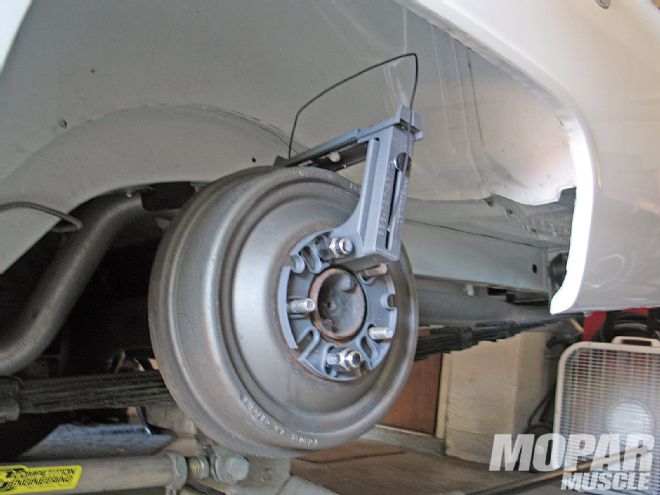 We wanted to see how easy the WHEELRITE tool is to use, so we set it by what diameter wheel we wanted, and then kept changing the width and backspacing measurement to get the largest possible measurement that will fit.
We wanted to see how easy the WHEELRITE tool is to use, so we set it by what diameter wheel we wanted, and then kept changing the width and backspacing measurement to get the largest possible measurement that will fit.
So there you have it, if you still have some concerns about measuring for your backspace, check out www.moparmusclemagazine.com or www.holeshotwheels.com, and you'll find a couple of diagrams to help you decide what size you need.